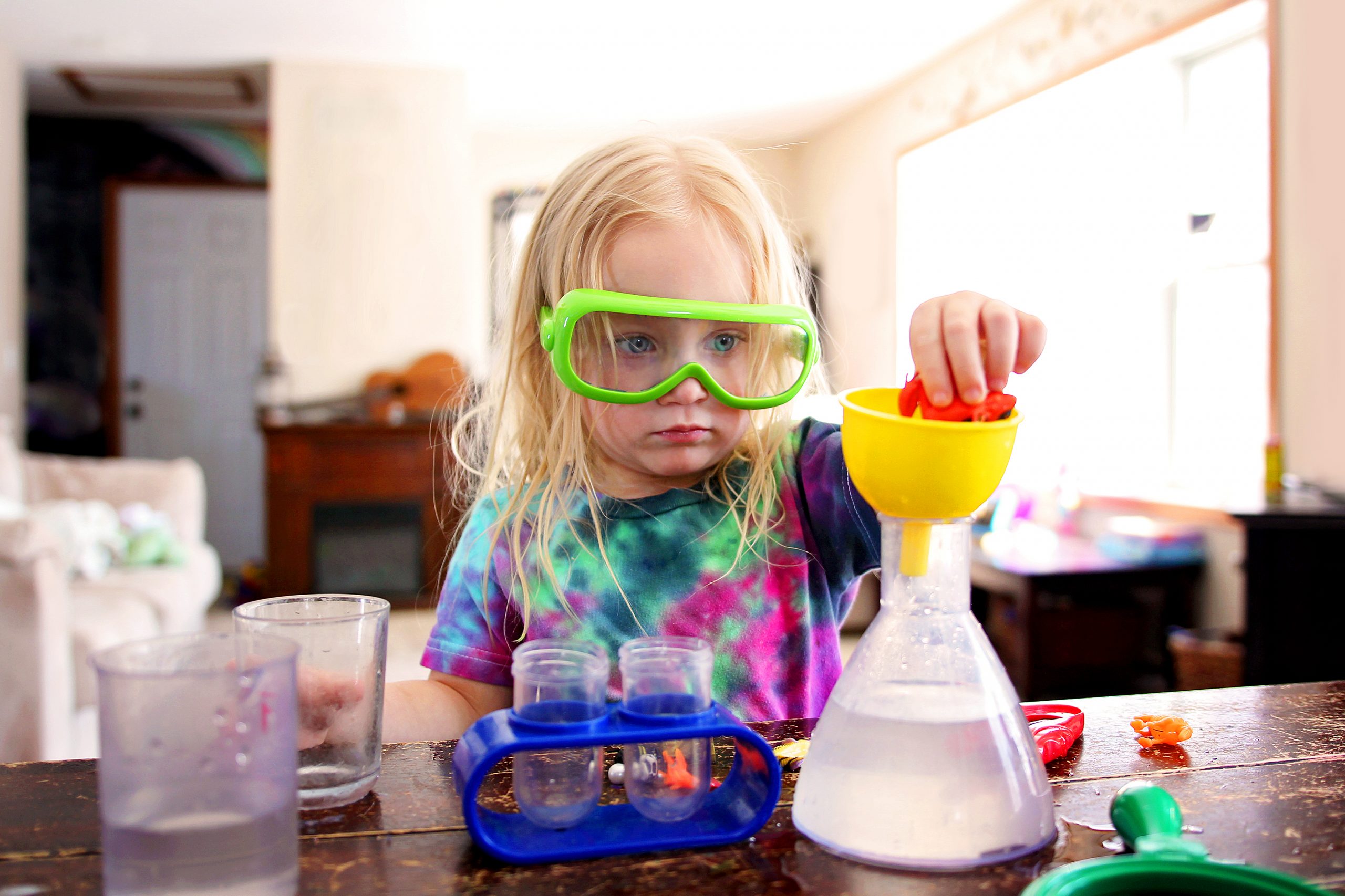“Mom, can you help me with my science?” I was thrilled to hear these words from my teen daughter. I don’t have to help her with schoolwork much, so I was excited to do some science together! Imagine my disappointment that my role in the experiment consisted of holding a flashlight so she could see. She had forgotten to take her measurements while it was light (and warmer) outside.
During the pandemic, many parents are facilitating remote learning for their kids. We see that kids are yearning for an in-person and hands-on learning experience. We are also spending more time at home together, and doing a science experiment together is both fun and educational. It can take the place of a trip to a local science museum. The magic of nature centers and science museums is that hands-on experiences are designed to amaze visitors. Being surprised by how the world works right in front of you creates an emotional connection to the material. Hands-on experiences are better at teaching concepts to kids and foster curiosity. And curiosity is the driving force of science.
As scientists we spend our days thinking about chemistry, biology, and fluorescence. Nevertheless, it can be hard to find appropriate activities to do with our kids at home. We are likely talking about science and exploring the world with our kids through that lens already. Receiving an ice cream delivery at home with dry ice can start conversations about solids and gases and phase transitions.
We probably don’t often spend our time thinking about chemistry and biology from a beginner’s point of view because we take our knowledge for granted. Playing at science with your kids is an opportunity to view the world as a novice again. While there is a lot of value in setting up systematic learning beginning with the scientific method, the informal exploration and experimentation feel like play. Now that so much of school and work is happening at home, we need some time to play.
To find new ideas for creating fun and magic of a visit to a science museum here at home, I asked the other Biotium scientists what experiments they enjoy doing with their kids. Alexis Madrid, a senior scientist, mentioned she purified DNA from strawberries at home. We also got suggestions to make rockets with baking soda and vinegar, growing microorganisms on potato slices, and making a pH indicator with cabbage. I also found some at-home fluorescence experiments that can be done with a low power blacklight flashlight.
While the baking soda and vinegar experiments have infinite variations and never get old, for us, it was time to find a new way to explore chemistry and biology at home. We started with the Strawberry DNA extraction experiment. All of the materials for this experience were everyday household items, and the protocol is straightforward and easy (protocol below). We saw the DNA precipitate in the isopropanol layer (rubbing alcohol), and we fished it out with a bamboo skewer.
Our conversations about the DNA extraction unfolded over the next few days. While we were doing the extraction, we discussed how the different extraction buffer components worked and why they were there. We also talked about the effect of detergents on proteins. As the experience sunk in, my daughter asked questions about what we observed and how it compares to extracting DNA in a lab setting. Finally, I asked her what she liked best, what surprised her, and what she learned. She was surprised by how much DNA we were able to collect. She was curious if it was this easy to get DNA from other fruit and if there would be as much of it. Our next two experiments will look for “germs” around the house using potato slices as a substrate and exploring light, fluorescence, and phosphorescence.
Doing science experiences with your kids at home opens up the world and allows you to share your love of science with them. It might even get you excited about basic science again. After all, we are all just trying to make the best of the pandemic, but sharing excitement about science can be one way to make this time more fun.
Isolating DNA from strawberries
Strawberries are well suited to isolating DNA because they contain a lot of DNA, and they also have pectinases and cellulases that help break down cell walls and proteins. The salt in the extraction solution contains detergent to help break open the cells and dissolve the lipid bilayers. The salt helps remove the proteins that are bound to DNA and helps keep the proteins in the aqueous layer while the DNA precipitates in the isopropanol.

Materials
Salt
Liquid Dishwashing detergent
Ice cold 70% Isopropanol (Rubbing alcohol, cool in freezer for 30 min.)
3-4 Strawberries
Prepare the extraction solution with
1/3 cup water
½ teaspoon salt
1 tablespoon liquid dishwashing detergent
- Mash the strawberries –we did this in a plastic Ziploc bag
- Add 3 tablespoons of extraction liquid and mash together well.
- Pour the strawberry mash into a coffee filter, a wet paper towel, or layers of cheesecloth to filter out the solids.
- When the liquid has drained into the jar, slowly add ice cold rubbing alcohol to form a layer on top of the strawberry liquid. The DNA precipitates in the interface between the strawberry extract and the alcohol layer.
If you have a small microscope at home, it is fun to look at the DNA strands. A fun follow-up activity, with delicious results, is to explore proteases present in fruit by making gelatin dessert with fruit.
Resources for more at-home science fun:
Explore fluorescence
Biotium is a life science reagent company specializing in fluorescent dyes, so I got a handheld low power blacklight to look for fluorescence in items found around the house. (You can buy a blacklight bulb at your local hardware store or a blacklight flashlight for about $10 from Amazon) Some items that will show fluorescence are:
- Petroleum jelly (blue light)
- Club soda or tonic water (blue-white)
- Vitamins: Vitamin A, Vitamin B12, thiamine, niacin & riboflavin
- White vinegar mixed with B12 to get yellow light
- Highlighter pens
- Glowsticks phosphoresce and provide an opportunity to talk about the difference and to learn about reaction rates
Websites with K-12 science ideas
Make rockets powered with baking soda and vinegar
Glow in the dark science fun
Making a pH indicator with red cabbage
Exploring photosynthesis with spinach disks
Physics Activities
k-12 science experiments to try at home
Introduction to the scientific method
Environmental Science activities to do at home







